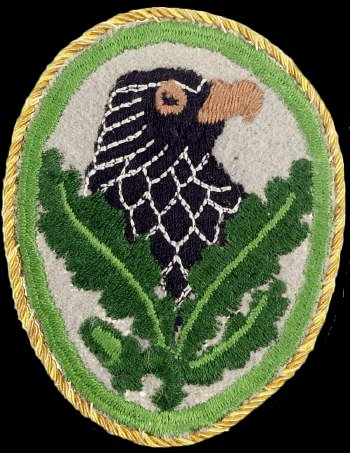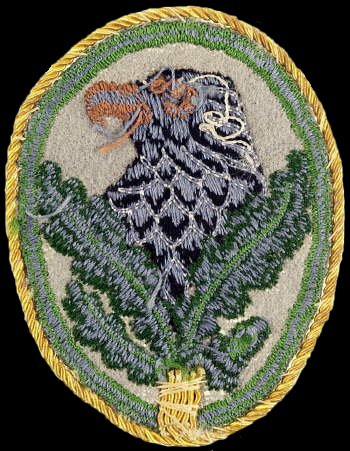
by Markus Lippl
Before the sniper badge was introduced, unit sniperís were awarded with Iron
Cross. The ongoing conflict
in the east with its threat of soviet snipers made it necessary to create a badge visually distinguishing
skilled and successful German (counter-)snipers in their units.
On August 20th, 1944, approximately one year after the first discussion on the introduction of such award had
begun and then was suspended, the FŁhrer instituted a special sniperís badge (Scharfschuetzen-Abzeichen) for
the Army and SS-Verfuegungstruppe (later changed into the Waffen-SS). The badge was to honor the marksman
with his rifle, his success in the aimed single shot and at the same time being a motivation to show higher
performance in the future.
Manufacturing and Technical information
The badge consists of an oval gray fabric shield which
usually measures approx. 70 mm in height and 55 mm in width. The oval shield has a 2mm wide may-green
surrounding border. Located in the center is a black eagleís head looking to the right with white chain
stitching on its body. The eye and closed beak are stitched in orange/brown thread.
The lower half of the badge shows to larger oakleaves both touching the shield borders left and right near the center of the
badge. Below the left oakleave is a small oak and opposite of it a smaller additional
oakleave. The fibers/veins of the oakleaves are may-green in color.


Regulations:
- The sniper badge is to be awarded by the next superior having the authority of at least a Regimental
commander upon written request of the unit leader, to designated and trained snipers. The receiver of the
award is to be presented with an award certificate and the award is to be entered
into his personal papers.
- The badge is to be divided into 3 grades and is
to be worn on the lower right sleeve. In case a soldier is wearing a specialistís badges or will receive one
next to the sniperís badge the same is to be worn below the sniperís badge.
- It will be awarded:
- Grade I - for a minimum of 20 enemy kills, starting from Sept. 1st, 1944 (badge without specific surrounding)
- Grade II - for a minimum of 40 enemy kills, starting from Sept. 1st, 1944 (badge with silver cord)
- Grade III - for a minimum of 60 enemy kills, starting from Sept. 1st, 1944 (badge with golden cord)
- For each successful kill the unit has to be given a report and confirmation of minimum one witness. The unit will issue sniper lists based on these reports. An extract of this list is to be passed on to the new unit along with other personal papers upon transfer. A retrospective accreditation of kills (prior to Sept. 1st, 1944, the Author) will not be allowed in order to evade unnecessary paperwork. It is being suggested to honor the previous achievements by awarding Iron Crosses.
Around December 1944 / January 1945 the regulations changed: From now on, following the will of
Adolf Hitler, all soldiers engaged in ground combat, were qualified to be awarded the sniper badge.
This included the Luftwaffe and Kriegsmarine.
Presentation, Wear and Documents
According to the award regulations the certificates had to be organized by the awarding units on their own. Towards the end of the war this led to simple typewriter written award certificates only bearing the official wording, stamp of the issuing unit and the signature and rank of the unitís commanding officer.
The badge was to be worn on the lower right sleeve of
the tunic above the cuffs. According to the Kriegsmarine regulation dated January 3rd, 1945 an
awarding unit was to request 2 badges for each sniper form the OKM Mar Wehr/ Tr II vk.
However, after all
German snipers in Soviet captivity were executed at once the Oberkommando order that before becoming a POW
one had to remove and conceal the badge.
Remark:
Due to the fact that the badge was issued late in the war, to a limited number of
personnel, that it was not produced by the other well-known badge firms and that
it was usually destroyed or thrown away before captivity or after May 1945, the badge is considered
by many collectors as extremely rare and itís differently manufactured versions make it critically
acclaimed in terms of fakes. There are a lot of fakes in circulation of which some
do not go in line with the images shown in
contemporary literature such as the Marineverordnungsblatt dd. 03.01.1945 or the
Allgem. Heeresmitteilung and Deutsche Uniformen Zeitschrift 10/1944, page 3). Others are not produced from old
wool mtrl and make use of modern dyes. A completely woven 4-colour example is regarded as 100 pct. post
May 1945 production.
![]()
© Copyright Wehrmacht-Awards.com LLC |